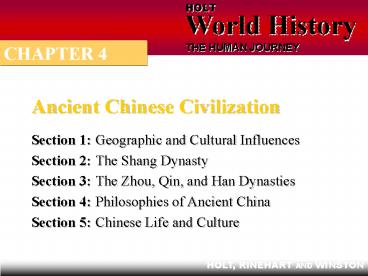Ancient Chinese Civilization PowerPoint PPT Presentation
1 / 27
Title: Ancient Chinese Civilization
1
Ancient Chinese Civilization
CHAPTER 4
- Section 1 Geographic and Cultural Influences
- Section 2 The Shang Dynasty
- Section 3 The Zhou, Qin, and Han Dynasties
- Section 4 Philosophies of Ancient China
- Section 5 Chinese Life and Culture
2
Objectives
Section 1
Geographic and Cultural Influences
- Explore the role that rivers played in Chinese
life. - Investigate how geography influenced the
development of Chinese culture.
3
The Physical Setting
Section 1
Geographic and Cultural Influences
- Different regions Qinling Shandi, China Proper
- The rivers of China
- Huang- loess- gives river yellow tint.
- Chang
- Xi
4
Satellite View of China
5
China
China vs. the U. S. in Size
United States
6
Chinas Isolation
Section 1
Geographic and Cultural Influences
- Zhongguo (Middle Kingdom)
- Lack of contact with foreigners
7
The Great Wall of China
8
Agricultural Regions in China
9
Objectives
Section 2
The Shang Dynasty
- Examine how the Chinese explained their early
history. - Describe how the Shang government and economy
were organized. - Identify the religious beliefs held by the Shang.
- Explain why the Shang dynasty collapsed.
10
Legends of Ancient China
Section 2
The Shang Dynasty
- Pangu first man, created universe
- Yu drained floodwaters
- Xia line of kings
- Tang First Shang leader
11
Government and Culture
Section 2
The Shang Dynasty
- Economy and handicrafts agriculture, artisans
- Astronomy and the calendar
12
Shang Dynasty
13
Religion in the Shang Period
Section 2
The Shang Dynasty
- Animism
- Festivals
- Shangdi
- Priests tried to predict the future using oracle
bones
14
Language and Writing
Section 2
The Shang Dynasty
- Ideographs
- Calligraphy
15
Fall of the Shang Dynasty
Section 2
The Shang Dynasty
- Battles with neighboring states
- Zhou
16
Objectives
Section 3
The Zhou, Qin, and Han Dynasties
- Explain why the Zhou fell from power.
- Describe how the Qin dynasty used power to
maintain its authority. - Identify the achievements of the Han emperors.
17
The Zhou Dynasty
Section 3
The Zhou, Qin, and Han Dynasties
- Mandate of Heaven
- Attacks by outsiders
- Fighting within
18
The Qin Dynasty
Section 3
The Zhou, Qin, and Han Dynasties
- Autocracy
- Great Wall of China
19
The Han Dynasty
Section 3
The Zhou, Qin, and Han Dynasties
- The civil service system
- Other accomplishments leveling, Silk Road
20
Objectives
Section 4
Philosophies of Ancient China
- Examine why the Chinese valued the concept of
balance. - Explore what the Chinese philosopher Confucius
taught. - Analyze how Daoism and Confucianism worked
together in Chinese society. - Investigate how beliefs such as Legalism and
Buddhism influenced Chinese history.
21
Ancient Chinese Beliefs
Section 4
Philosophies of Ancient China
- Yin
- Yang
- Balance is normal condition
22
Confucius and Laozi
Section 4
Philosophies of Ancient China
- Confucianism strong but moral government
- Daoism nature, harmony, balance
23
Legalism and Buddhism
Section 4
Philosophies of Ancient China
- Legalism in practice balance between Legalism
and Buddhism - Buddhism in China universal charity and
compassion
24
Objectives
Section 5
Chinese Life and Culture
- Explain why the family was a central institution
in Chinese society. - Describe how farmers lived in ancient China.
- Identify the artistic and scientific achievements
of the Chinese.
25
Family and Social Life
Section 5
Chinese Life and Culture
- Genealogy
- Women had few rights and powers
- Great respect for mothers
26
The Economy
Section 5
Chinese Life and Culture
- Small village farmers
- Qin dynasty standardized currency, weights, and
measures
27
Arts and Sciences
Section 5
Chinese Life and Culture
- The Five Classics used to train scholars and
civil servants - Science and technology astronomy, seismography,
clocks, acupuncture, paper-making, and printing

